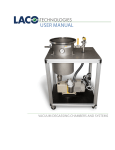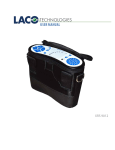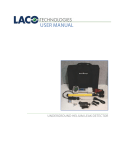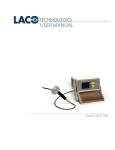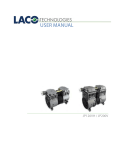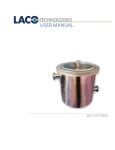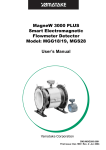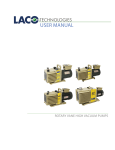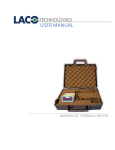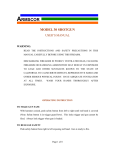Download SMT-09-1002 revA2 Vacuum Degassing Chambers and Systems.indd
Transcript
USER MANUAL VACUUM DEGASSING CHAMBERS AND SYSTEMS CONTACT US PHONE/FAX Toll Free: 800.465.1004 Phone: 801.486.1004 Fax: 801.486.1007 ADDRESS LACO Technologies, Inc. 3085 West Directors Row Salt Lake City, UT 84104 WEB www.lacotech.com [email protected] SMT-09-1002 Rev A2 ii © 2010 LACO TECHNOLOGIES, INC. CONTENTS 1. SCOPE .................................................................................... 1 2. SAFETY .................................................................................. 1 3. COMPONENTS ..................................................................... 1 4. BASIC OPERATION .............................................................. 3 5. RECOMMENDED PROCEDURES ....................................... 4 6. APPENDIX A: REMOVAL OF AIR FROM LIQUIDS ................................... 5 7. APPENDIX B: CARING FOR ACRYLIC ........................................................ 8 8. APPENDIX C: SPARE PARTS AND ACCESSORIES ................................... 9 iii © 2010 LACO TECHNOLOGIES, INC. LACO USER MANUAL - VACUUM DEGASSING CHAMBERS AND SYSTEMS 1. SCOPE This manual outlines the components, safety information, recommended maintenance for LACO Technologies Vacuum Degassing Systems. Following these recommended procedures will ensure that your degassing system is performing at its highest level. This manual also includes product information for degassing systems, including accessories, options, and spare parts. 1.1 MAKEUP OF A DEGASSING SYSTEM A typical vacuum degassing systems includes a vacuum chamber connected to a vacuum pump for removing trapped gases from compounds. With the appropriate vacuum pump degas chambers are used to reduce the pressure above the surface of the material and permit escape and subsequent removal of entrapped air and other gases that could induce failure of the final product. Degas chambers and pumps are available with several options and accessories for a complete vacuum degas system to meet your requirements. 2. SAFETY 2.1 VACUUM PUMP SAFETY A complete manual will be provided for the vacuum pump and should be referred to for safety issues relating to the specific vacuum pump purchased. 2.2 VACUUM CHAMBER SAFETY All degassing chambers are designed for holding full vacuum, but any defects, cracks or severe wear should be reported to LACO for advisement. Vacuum chambers are not designed for pressure applications. If slight pressure is needed (5 psi or less) the chamber must be provided with necessary clamps and pressure safety relief valves. 3. COMPONENTS A vacuum degassing system comprises of two main items; a vacuum chamber and vacuum pump. Several accessories and options can be added to customize the degassing system. Systems are available in modular configurations or as complete setups mounted onto carts or stands. 1 © 2010 LACO TECHNOLOGIES, INC. LACO USER MANUAL - VACUUM DEGASSING CHAMBERS AND SYSTEMS 3.1 VACUUM CHAMBERS The most common vacuum degassing chamber is a cylindrical vessel, fitted with a vacuum control valve, vacuum release valve, vacuum dial gauge, “L” type gasket and a clear acrylic or metal lid. The cost of cylindrical vacuum chambers tend to increase far more with increases in diameter than length. Horizontal chambers will also be more than corresponding vertical chamber due to the need for cradle supports and lid hinging. This orientation is preferred if the product is easier to load and monitor. A common option for horizontal chambers include shelf support rails and removable shelves. Vacuum degas chambers are most commonly made from 304 stainless steel however LACO offers vertical chambers also in aluminum and clear acrylic for full viewing. To select a chamber for your purpose, ensure that your container will fit into the chamber with sufficient space to allow for expansion of the liquid to be degassed. Initially, fill your container one quarter with mixture, experience will show the limit of mixture level permissible. 3.2 VACUUM PUMP AND HOSE Based on the application the vacuum pump can be the greatest cost and the most critical component for successful degassing. Choices range from dry membrane pumps capable of vacuum levels down to 60 Torr or 27 inHG for single stage models and 7 Torr or 29 inHG for two stage models. These dry pumps have pumping speeds or cfm values ranging from 1 to 7 cfm. For higher vacuum levels and cfm values, oil sealed rotary vane vacuum pumps are used. Single stage models are capable of vacuum down to 0.5 Torr and cfm from 1 to 100 cfm. Two stage models are capable of vacuum down to 0.005 Torr or 5 millitorr and range in cfm from 2 to 50 cfm. When selecting a pump it is necessary fully degas the mixture before it even begins to gel or set. Knowing the pot life of the material will help in selecting the right speed or cfm of pump. The manufacturer of the material may recommend a vacuum level based on the properties of the material. If you are unsure of the vacuum level requirement it is always easier to have more vacuum than less. 3.3 COMMON ACCESSORIES • Vacuum traps protect the vacuum pump from contaminates during the degassing process and also prevent backstreaming of pump oil into the vacuum lines or chamber. • Digital vacuum gauges with units in torr or millitorr to accurately monitor and repeat the process at the same vacuum level. • Chamber mixers with rotary shaft feedthroughs 2 © 2010 LACO TECHNOLOGIES, INC. LACO USER MANUAL - VACUUM DEGASSING CHAMBERS AND SYSTEMS • Chamber internal platen heaters • Heating blankets can be fitted around the vacuum chamber to achieve higher wall temperatures. Heaters are NOT suitable for use with clear acrylic doors. • Electrical and thermocouple feedthroughs • Liquid feedthroughs and valves 4. BASIC OPERATION Degassing of a liquid mixture is the removal of air bubbles which become entrapped in the mixture when mixing the components. See Appendix A for a complete discussion on vacuum degassing. The following is a quick review of procedures for removal of air bubbles from resin mixes, RTV silicone and similar liquids. 1. Close the vacuum valve connected to the vacuum pump and switch the vacuum pump ON and allow to warm up. 2. Open the vacuum release or vent valve and remove the chamber lid. 3. Mix the materials to be degassed in a suitable container not more that 1/3 to 1/2 full and place this container in the chamber. 4. Replace the lid, making sure it fully covers the gasket on the vacuum chamber. 5. Close the vacuum release valve. 6. Open the vacuum valve. 7. Watch the mixture and the vacuum gauge. When the chamber is undergoing the evacuation the mixture will begin to rise, slowly at first. At nearly full vacuum the mixture will have swollen up to fill the mixing vessel, air bubbles will appear and burst at the mixture surface. After a few seconds, this mixture will collapse to near its original volume. Occasional bubbles will appear at the surface. 8. If the mixture rises too fast and is likely to overflow the container then momentarily reduce the vacuum by opening and closing the vacuum release valve or closing the vacuum valve. Repeat if necessary. 9. Wait for about 30 seconds after the collapse and close the vacuum valve. 3 © 2010 LACO TECHNOLOGIES, INC. LACO USER MANUAL - VACUUM DEGASSING CHAMBERS AND SYSTEMS NOTE One can also monitor the time and vacuum level on the vacuum gauge as well as the material, to determine the length of time to hold it under vacuum. The length of time to degas is highly dependent on the product and the particular application. Often an absolute pressure vacuum gauge is used to monitor the vacuum level of the system and determine if gases or solvents are evolving from the product. The vacuum chambers are equipped with a relative 0-30 in HG vacuum gauge, which is mainly used to determine a rough vacuum level. For more accurate measurement and control of the process, contact LACO about an absolute vacuum gauge. 10. Open the vacuum release valve and remove the lid. 11. Fill the mold(s) carefully to minimize trapped air. 12. If necessary, place the mold(s) into the vacuum chamber. 13. Repeat stages above as necessary. 14. Some bubble may appear at the mixture surface and burst. 15. Continue degassing for about 30 seconds at full vacuum. 16. Repeat steps 10, 11, 12. 5. RECOMMENDED PROCEDURES 5.1 VACUUM PUMP OIL CHANGES The vacuum pump is the most critical maintenance item in a degassing system. For oil sealed rotary vane vacuum pumps the most critical maintenance item is to change the pump oil frequently. The frequency will depend on the application and usage but it is recommend that if the oil ever turns cloudy, dark or is foul smelling, change it immediately. Any degassed solvents, water or other liquids will condense in the pump oil and lower the vacuum level the pump is able to achieve. Frequent oil changes will also extend the life of the vacuum pump. When changing pump oil it is recommended to also use a flushing fluid to cleanse the pump. LACO’s LVOFF is a hydrocarbon fluid specifically designed to assist in the internal cleaning of particles and sludge build-up in mechanical vacuum pumps. Its low viscosity helps free contamination from internal parts allowing it to be flushed from the pump through the drain valve. 4 © 2010 LACO TECHNOLOGIES, INC. LACO USER MANUAL - VACUUM DEGASSING CHAMBERS AND SYSTEMS 5.2 FLUSHING PROCEDURE 1. Drain the used fluid from the pump while still hot from operation and refill with LVOFF. 2. Run the pump blanked off or isolated for approximately 20-30 minutes or until pump is hot. 3. Drain the pump completely (open gas ballast and jog the pump to aid in removing oil). 4. Repeat the procedure if necessary then refill with LACO 19 grade oil for direct drive pumps of 195 grade for belt drive pumps or other oil as specified. WARNING Any foreign material left remaining in the vacuum chamber or vacuum hose lines can contribute to outgassing and reduce the performance of the system and the vacuum pump. 6. APPENDIX A: REMOVAL OF AIR FROM LIQUIDS 6.1 APPLICATIONS • RTV Silicone Rubber • Araldite • Polyester Resin • Plastasols • Casting Plaster • Polysulphide Rubber • Polyurethane Resin • Adhesive Mixes • Epoxy Resins • Investment Plaster 6.2 INTRODUCTION When any of the above listed materials are mixed with the required additives, accelerator, filler etc., then air bubbles can become trapped within the mixture. If not removed before the material cures the air bubbles can cause defects such as nodules, cavities, hollows in the finished cast. Sometimes such defects remain out of sight just below the surface only to appear after a period of use. With electrical and electronic encapsulation then these cavities can give rise to electrical breakdown. On art figures cavities or nodules require correcting, which increases the time and costs for a piece. 5 © 2010 LACO TECHNOLOGIES, INC. LACO USER MANUAL - VACUUM DEGASSING CHAMBERS AND SYSTEMS Mixing can be done by hand or an electric mixer before degassing, depending upon the quantities involved. It depends on the amount and type of filler and resin. The components are mixed in a container. It is essential that the resulting mixture behaves as a liquid, i.e., flows and can be poured. When this mixture is put into the vacuum chamber and the air pressure above it reduced, i.e. evacuated, the air bubbles which were formed at atmospheric pressure now expand and rise to the surface where they burst. The air thus released is pumped away. In practice, degassing causes the whole mixture to expand about two to six times its original volume. As the bubbles burst at the surface, the expansion decreases. This process can take up to several minutes depending upon the nature of the mixture, the volume of the vacuum chamber and the speed of the vacuum pump used. After expansion has subsided, bubbles can still appear at the surface, which is mainly caused by the escape of traces of remaining air plus volatile components of the mixture boiling off. The vacuum should only be held for a further 30 seconds to 60 seconds at this stage, otherwise the composition of the mixture will be altered and setting time will change due to volatile components being removed by the vacuum. This degassed mixture is then poured into your mold taking care to minimize any trapped air. When your mold has been filled if you desire you can put the whole mold with mixture into the vacuum chamber and evacuate as before. This time only one or two bubbles should appear from air, which was trapped in undercuts or adhering to the mould surface. Again, beware of boiling off the volatile components, only a few seconds or so at full vacuum should be sufficient. You should be able to complete the above process long before the material begins to gel or increase in viscosity. If degassing is too slow, you may need to either increase the evacuation speed, i.e., change the pump (to a larger cfm) or the decrease chamber size to reduce the pump down time, or decrease the accelerator or possibly keep the components warm in very cold weather. 6.3 COMMON CAUSES OF BUBBLES IN CASTINGS • Air inclusion during mixing the resin and hardener together. • Air trapped in moulds. • Air trapped due to improper casting/moulding techniques. • Air introduced by suction as the material shrinks or due to a leaking tool. • Trapped residual solvent vapors from certain types of mould releases. 6 © 2010 LACO TECHNOLOGIES, INC. LACO USER MANUAL - VACUUM DEGASSING CHAMBERS AND SYSTEMS • Volatile components being stripped out of the materials while casting under vacuum. • Gases generated during the reaction (hardening) process. • Gases formed during improper storage (moisture contamination etc.) • Gases introduced through pressurized systems. • Air from improperly degassed resin and/or hardener. 6.4 FACTORS THAT AFFECT THE REMOVAL OF GASES • VISCOSITY OF THE MIX. The higher the viscosity the more difficult it is to remove gases • SURFACE TENSION OF THE MATERIALS Can be reduced by heating and the addition of surfectants • TEMPERATURE OF THE MIX. Heating the material will reduce the viscosity. Be sure to consider the pot life and gel time before heating any mixed materials. • AMOUNT OF MATERIAL BEING DEGASSED AT ONE TIME. The depth to surface ratio is important. The larger the surface that is exposed to the vacuum the better. The lower the amount of product the rising bubbles have to travel through the better. • AGITATION Agitation (mixing) during the degassing process (while under vacuum) will speed the removal of air. • VACUUM PUMP SIZE The size or pumping speed of your vacuum pump usually noted in terms of cubic feet per minute or cfm as well as the ultimate pressure or vacuum level your pump can achieve. • CHAMBER SIZE AND PIPING Chamber size and the diameter and length of the vacuum hose can also effect the time for removal of gases. It is recommended to use at least the same diameter as your pump inlet and to use the shortest length hose as possible. 6.5 MIXING UNDER VACUUM Some materials need to be mixed under vacuum in order to obtain an air free material. Some materials may also need heating before or during mixing. Such material may need constant agitation or vibration to keep them fluid so that they will actually flow as fluids to fill moulds and containers. In such cases LACO can review the application and recommend suitable vacuum equipment. 7 © 2010 LACO TECHNOLOGIES, INC. LACO USER MANUAL - VACUUM DEGASSING CHAMBERS AND SYSTEMS 6.6 COMPLETION OF PROCESS BY PRESSURE After subjecting the liquid material to a vacuum to remove entrapped air the voids and spaces are probably still present but in vacuum. The final stage of the process is to release the vacuum in the chamber, i.e. admit the atmosphere which exerts a pressure of about 14.7 pounds on every square inch. It is this pressure that pushes the material into the voids undercuts and crevices of the mould. It is essential that the vacuum is released immediately after degassing. It may help to gently vibrate the mould full of material to temporarily overcome any tendency of the material to be thixotropic, i.e., non-flowing such as with certain casting plaster mixes. If the material has already begun to set while in vacuum and the surface is not smooth but sponge like, then upon release of the vacuum air will enter the body of the material and create a gassy cast. Should this happen then vibration under vacuum and during vacuum release is needed so that the material flows in to all the cavities. 7. APPENDIX B: CARING FOR ACRYLIC 7.1 WASHING Wash acrylic with a solution of mild soap or detergent and lukewarm water. Use a clean soft cloth, applying only light pressure. Rinse with clean water and dry by blotting with a damp cloth or chamois. Grease, oil, or tar may be removed with a good grade of hexane, aliphatic naphtha, or kerosene. These solvents may be obtained at a paint or hardware store and should be used in accordance with manufacturer’s recommendations. DO NOT USE: Window cleaning sprays, kitchen scouring compounds or solvents such as acetone, gasoline, benzene, alcohol, carbon tetrachloride, or lacquer thinner. These can scratch the sheet’s surface and/or weaken the sheet causing small surface cracks called “crazing.” Acrylic can be cleaned with the following commercial cleaners without damaging the coated surface: Fantastik household cleaner, Formula 409 household cleaner, Glass Plus cleaner, Mr. Clean household cleaner, Top Job household cleaner, and Windex window cleaner. It is not recommended to use abrasive cleaners. 7.2 POLISHING Protect acrylic and maintain its surface gloss by occasional polishing with a good plastic cleaner and polish. Apply a thin, even coat with a soft, clean cloth and polish slightly with cotton flannel. Then wipe with a damp cloth to help eliminate electrostatic charges that can attract dust particles. 8 © 2010 LACO TECHNOLOGIES, INC. LACO USER MANUAL - VACUUM DEGASSING CHAMBERS AND SYSTEMS 7.3 REMOVING SCRATCHES Fine scratches can be removed by hand polishing. Apply a plastic scratch remover to a soft flannel pad and rub. When the scratches have disappeared, remove all residue and polish. For deeper scratches, first sand lightly with a 400-grit “wet or dry” sandpaper, using plenty of water and rinsing the sandpaper frequently. Follow by buffing with a clean muslin wheel and a good polishing compound. For the highest gloss, use a clean-up wheel made of soft cotton or flannel sections and on which no compound is used. An electric drill with a buffing wheel is ideal. 8. APPENDIX C: SPARE PARTS AND ACCESSORIES For information on recommended spare parts and accessories, see the following tables: • Table1: Element Types for Clear Vacuum Types • Table 2: Vacuum Pump Oil and Grease • Table 3: Oil Mist Eliminators • Table 4: PVC Vacuum Hose with NW Flanges • Table 5: Vacuum Hose Fittings • Table 6: Vacuum Gauges • Table 7: Vacuum Chamber Fittings and Valves • Table 8: Chamber Gaskets • Table 9: Clear Vacuum Traps and Replacement Elements LACO recommends to have one gallon of vacuum pump oil and one gallon of flushing fluid along with a spare chamber lid gasket. Also, silicone vacuum grease is also helpful for lubrication on the lid gasket to ensure quick and easy vacuum sealing. If the chamber is equipped with a filter trap, replacement elements are also recommended. 9 © 2010 LACO TECHNOLOGIES, INC. LACO USER MANUAL - VACUUM DEGASSING CHAMBERS AND SYSTEMS Below is a list of various element types available for the clear vacuum traps. Table1: Element Types for Clear Vacuum Types ELEMENT TYPE DESCRIPTION Copper Gauze Large surface area traps condensable particles and oil vapors Stainless Steel Gauze Same as copper, but with added corrosion protection Molecular Sieve Reduces mechanical pump backstreaming and traps water vapor Sodasorb® Minimizes migration of corrosive chemicals and neutralizes acidic vapors Activated Charcoal Removes organic vapors Activated Alumina Removes Lewis acids, polar compounds, other acids, water and particles Polypro 2 Micron Traps high volumes of solids and particulates as small as 2 microns; available in three sizes Polypro 5 Micron Same as above Polypro 20 Micron Same as above Table 2: Vacuum Pump Oil and Grease DESCRIPTION 1 QUART 1 GALLON 5 GALLON 19 Grade, Direct Drive, VP1x10-5 Torr LVO191QT LVO191G LVO195G 20 Grade, High Quality, VP 1x10 Torr LVO201QT LVO201G LVO205G Flushing Fluid, All Pumps, Low Viscosity N/A LVOFF1G LVOFF5G Silicone Vacuum Grease LVO9140Z (4 oz Jar) -6 Table 3: Oil Mist Eliminators P/N DESCRIPTION SPARE ELEMENTS LOME20025 Compact, NW25 In, 1/2” Outlet, 10 cfm LGL915 LOME60025 15CFM Clear Housing Oil Mist Eliminator LGL150 (NW25) LOME30050 5 CFM Compact Oil Mist Eliminator (1/2” NPT) Table 4: PVC Vacuum Hose with NW Flanges P/N SIZE LVFP100N25 LMSA0953 1/2” I.D. LMSA0955 1” I.D. LMSA0986 3/8” I.D. LVFAN16D50A 1/2” I.D. x NW 16 LVFAN16H38A 3/8” I.D. x NW 16 LVFAN25H38A 3/8” I.D. x NW 25 LVFAN25H50A 1/2” I.D. x NW 25 10 © 2010 LACO TECHNOLOGIES, INC. LACO USER MANUAL - VACUUM DEGASSING CHAMBERS AND SYSTEMS P/N SIZE LVFP038 3/8” I.D. LVFP050 1/2” I.D. LVFP100 1” I.D. Table 5: Vacuum Hose Fittings P/N DESCRIPTION LVFCN25A Wing Nut Clamp LVFGN25SV Centering Ring SS/Viton LVFBN25S Blank-Off, SS LVFFLWN25S Flange Long Stub, SS LVFTN25S Tee, SS LVFTX25S Cross, SS LVFE90N25S Elbow, SS LVFAN25FP12S 1/8’ FNPT Adaptor, SS Table 6: Vacuum Gauges P/N DESCRIPTION LVG-3025B 0-30 in HG Vacuum Gauge, SS Case, 1/4” NPT Bottom Mount LVG-3025B 0-30 in HG Vacuum Gauge, SS Case, 1/4” NPT Rear Mount LVG-200TC Digital Thermocouple Display, Sensor & Cable Table 7: Vacuum Chamber Fittings and Valves P/N DESCRIPTION LMSA8001 1/2’ MNPT Adaptor to NW25 - SS LMSA8002 3/4” MNPT Adaptor to NW25- SS LMSA8003 1/4” MNPT x FNPT Mini Ball Valve LMSA8043 1/2” MNPT x FNPT Mini Ball Valve LMSA8005 3/4” FNPT Ball Valve LMSA8006 1/4” NPT Bronze Muffler LMSA8007 1/2” NPT Bronze Muffler Table 8: Chamber Gaskets CHAMBER BUNA LID GASKETS P/N Chamber Diameter LG06B 6” LG08B 8” LG10B 10” LG12.75B 12.75” LG18RB 18” LG24RB 24” 11 © 2010 LACO TECHNOLOGIES, INC. LACO USER MANUAL - VACUUM DEGASSING CHAMBERS AND SYSTEMS Table 9: Clear Vacuum Traps and Replacement Elements P/N DESCRIPTION MV300005 4.5” Clear Trap, No Insert MV300010 9.5” Clear Trap, No Insert MV300100 9.5” Clear Trap, with Copper Gauze MV300105 4.5” Clear Trap, with Copper Gauze MV300200 9.5” Clear Trap, with SS Gauze MV300205 4.5” Clear Trap, with SS Gauze MV300300 9.5” Clear Trap, with Molecular Sieve MV300305 4.5” Clear Trap, with Molecular Sieve MV300400 9.5” Clear Trap, with Sodasorb MV300405 4.5" Clear Trap, with Sodasorb MV300500 9.5" Clear Trap, with Activated Charcoal MV300505 4.5" Clear Trap, with Activated Charcoal MV300600 9.5" ClearTrap, with Activated Alumina MV300605 4.5" Clear Trap, with Activated Alumina MV300610 9.5" Clear Trap, with PolyPro 2 micron MV300615 4.5" Clear Trap, with PolyPro 5 micron MV300620 9.5" Clear Trap, with PolyPro 5 micron MV300625 4.5" Clear Trap, with PolyPro 5 micron MV300630 9.5" Clear Trap, with PolyPro 20micron MV300635 4.5” Clear Sump with PolyPro 20 micron MV300900 Replacement Element, 9.5" Copper Gauze MV300905 Replacement Element, 4.5" Copper Gauze MV300910 Replacement Element, 9.5" Stainless Steel MV300915 Replacement Element, 4.5" Stainless Steel MV300920 Replacement Element, 9.5" Molecular Sieve MV300925 Replacement Element, 4.5" Molecular Sieve MV300930 Replacement Element, 9.5" Sodasorb MV300935 Replacement Element, 4.5" Sodasorb MV300940 Replacement Element, 9.5" Activated Charcoal MV300945 Replacement Element, 4.5" Activated Charcoal MV400910 Replacement Element, 9.5" Activated Alumina MV400915 Replacement Element, 4.5" Activated Alumina MV400920 Replacement Element, 9.5" Polypro 2 MV400925 Replacement Element, 4.5" Polypro 2 MV400930 Replacement Element, 9.5" Polypro 5 MV400935 Replacement Element, 4.5" Polypro 5 MV400940 Replacement Element, 9.5" Polypro 20 MV400945 Replacement Element, 4.5" Polypro 20 LMSA8001 1/2”MNPT Adaptor to NW25 - SS LMSA8002 3/4”MNPT Adaptor to NW25 - SS 12 © 2010 LACO TECHNOLOGIES, INC.















